An Artificial Intelligence (AI) chatbot with the most uncreative name Chat Generative Pre-trained Transformer or ChatGPT for short is making huge waves in the tech community across the world. Some hail it as the bold new frontier. The tool has also raised questions about academic dishonesty, plagiarism, misinformation and biases.
Just the other day it passed an MBA exam given by a Wharton University professor. Many universities have banned its use on campus for fear of students using it for projects and exams. Each day more and more exciting reports are coming out about the exploits of ChatGPT.
It understands natural language the way we humans speak and can give a written output on almost anything you throw at it. It can write logical, sensible articles on almost any topic under the sun. It can edit text, it can translate. It can code perfectly on request. You can throw in the transcript of a 40 minutes speech and get a summary of it in 100 words in seconds. It is as if the bot is tapping into the whole collection of human knowledge from a repository somewhere. It all happens in real-time.
The interface is simple and awe-inspiringly efficient. ChatGPT’s capability to carry out a human-like conversation has sparked thoughts about the possibility to replace human writers and even threaten Google’s search business.
We have been hearing about the progress researchers in Artificial Intelligence are making but this is the first time such an advanced experiment has been thrown open to the public. And the results have been overwhelming to say the least. ChatGPT has crossed one million users within five days of its launch and the user base has been growing ever since. Active userbase became 100 million in just two months.
Tech companies are either racing to tap a share of the market being opened by ChatGPT or trying to safeguard their interest in the path of the new cyclone. Microsoft confirmed a $ 10 billion investment in ChatGPT maker OpenAI in January, 2023.
And there are reasonable fears that it will wipe out millions of white-collar jobs shortly. Just what is this phenomenon?
What is ChatGPT?
ChatGPT was launched on November 30, 2022, by US artificial intelligence company OpenAI. It can answer questions, follow your suggestions and carry on an intelligent conversation with users. It remembers what a user said in previous conversations and allows the user to modify the conversation or add corrections. Unlike other companies experimenting with AI, Open AI has thrown it open to the public. This is to “allow developers to build conversational AI applications, such as chatbots and voice assistants, using the language generation capabilities of the model. This allows for wider usage and experimentation with the technology, and can drive advancements in the field,” company said.
‘Day 01 at OpenAI’
OpenAI CEO Sam Altman tweeted this picture on January 4 showing a picture taken on the opening day 7 years back.
ChatGPT is an AI model that generates human-like responses in a conversational manner. It is designed to be used in applications such as chatbots, virtual assistants, and customer service agents, where the goal is to generate text that is both informative and engaging. Yes, you just read it, assistants and customer service professionals – these are some of the first jobs ChatGPT could wipe out in a few months from now. Add researchers, editors and writers too. And remember, Chat GPT could turn out to be not even the most engrossing product yet from OpenAI. There are other strong contenders.
The new technology is built on OpenAI’s GPT-3 language model and the company is already working on its successor, GPT-4 model. OpenAI had earlier launched another path-breaking product – Dall-E image-generating model, which they claim 3 million people are already using. This accepts written prompts to synthesize art and other images.
Where is ChatGPT available?
ChatGPT is available globally over the internet. The OpenAI API (Application Programming Interface), which provides access to the model, can be used from anywhere with an internet connection. Similarly, pre-trained versions of the model can be downloaded and run locally as well as globally.
The API provides an interface for sending input to the models and receiving the generated text output, making it easy to integrate AI capabilities into several applications, including chatbots, language translation, content creation, and more. The API is available through a subscription-based pricing model.
Microsoft launches it in Teams
ChatGPT will very soon be coming to you via many of the apps. The newly launched Microsoft Teams Premium will be powered by ChatGPT, the company has announced. It will take meeting notes, recommend tasks and help create meeting templates for Teams users. The premium service will cost $7 per month in June before increasing to $10 in July, Microsoft said.
How can I access and use ChatGPT?
ChatGPT is available at www.chat.openai.com but you need to create an OpenAI account first to play around with it now. It is a simple process.
• Login to www.openai.com and go to the featured products. Click on ChatGPT.
• Click ‘Try ChatGPT’ on the next page.
• Signup for OpenAI here using your email id and phone number to create your account
• Verify your email account.
• Login to your account with the credentials
Paid plan announced
Apart from the free version, OpenAI has also launched a subscription version named ChatGPT Plus on Thursday, which according to the company, will offer faster response time and reliability during peak hours. It is available for $20 per month. Besides the above features, subscribers will have priority access to new features and improvements.
Record growth: 100m million active users in 2 months
ChatGPT is estimated to have reached 100 million monthly active users in January, just two months after launch, making it the fastest-growing consumer application in history, according to a UBS study on Wednesday.
The report, citing data from analytics firm Similar Web, said about 13 million unique visitors used ChatGPT per day in January, more than double the levels in December.
In 20 years following the internet space, we cannot recall a faster ramp in a consumer internet app,” UBS analysts wrote in the note.
What people are doing with ChatGPT

Image Credit: Vijith Pulikkal/Gulf News
Challenge to Google’s supremacy?
I don’t think we’ve yet seen the people go after the trillion dollar take on Google. And I think that’s about to happen. Maybe it’ll be successful. Maybe Google will do it themselves. But I would guess that with the quality of language models we’ll see in the coming years, there will be a serious challenge to Google for the first time for a search product.
– Sam Altman, CEO of OpenAI
OpenAI, the firm behind ChatGPT
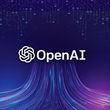
OpenAI was founded by Sam Altman, Elon Musk, Greg Brockman, Ilya Sutskever, Wojciech Zaremba and John Schulman in December 2015. Musk left the board in 2018 citing a possible conflict of interest with his Tesla project.

Image Credit: Vijith Pulikkal/Gulf News
The company was reportedly worth $26 billion soon after its deal with Microsoft in January, 2023.
Will it make Google redundant?

Well, no and may be. If you put this question to ChatGPT, its answer is negative.
The response is: “No, ChatGPT cannot make Google redundant. Google provides a wide range of services including search, email, cloud storage, and many others that go beyond the capabilities of a language model like ChatGPT. While ChatGPT can provide answers to questions and assist with various tasks, it is not designed to replace Google or any other comprehensive platform.”
However, Steve Altman, the CEO of OpenAI, clearly thinks otherwise. He believes, the AI scene that is emerging gives new technologies and firms an advantage over Google.
“Yeah. So I think so far, we’ve been in the realm where you can do an incredible copywriting business or you can do an education service or whatever. But I don’t think we’ve yet seen the people go after the trillion dollar take on Google. And I think that’s about to happen. Maybe it’ll be successful. Maybe Google will do it themselves. But I would guess that with the quality of language models we’ll see in the coming years, there will be a serious challenge to Google for the first time for a search product. And I think people are really starting to think about “How did the fundamental things change?” And that’s going to be really powerful,” he said in an interview with Reid Hoffman of Greylock in September 2022.
And that is a very powerful statement, given the near total supremacy of Google in the search market.
Google has already acted to counter the likely ChatGPT foray into its search domain. After all, the company sees itself as a pioneer in AI with products like DeepMind and LaMDA.
Alphabet and Google CEO Sundar Pichai told investors Thursday that it will add AI features to its search engine.
“Very soon, people will be able to interact directly with our newest, most powerful language model as a companion to Search, in experimental and innovative ways,” CNBC has reported him as saying. DeepMind is an artificial intelligence subsidiary of Alphabet while LaMDA, or Language Model for Dialogue Applications is its conversation technology.
Reports say it is already testing a chatbot called “Apprentice Bard’ internally. The measures also include redesigning its search interface to include the chat features.
Noam Chomsky is not a fan
Noted US intellectual and philosopher Noam Chomsky is skeptical about the use of ChatGPT in education. He thinks it is just high-tech plagiarism.
I don’t think it has anything to do with education, except undermining it. Chat GPT is high-tech plagiarism. It is a system that accesses an astronomical amount of data and finds regularities and string them together. Looks more or less like what somebody could have written on the topic.
– Noam Chomsky
AI market to touch $500 billion
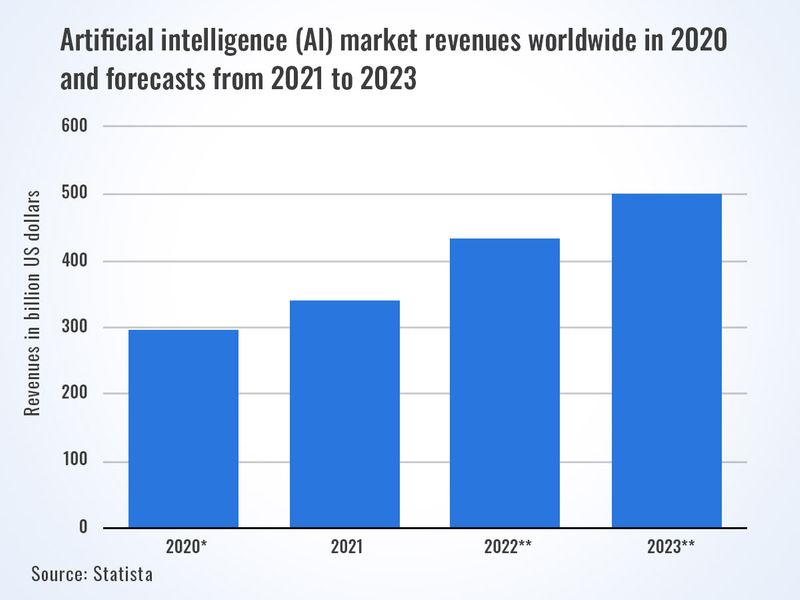
Image Credit: Vijith Pulikkal/Gulf News
Is there a copyright to ChatGPT content?
ChatGPT uses a general disclaimer that any text generated by it is owned by OpenAI and is protected by copyright. You need to get permission from OpenAI for any commercial or non-commercial use of text generated by ChatGPT.
It also permits limited use of the text for non-commercial purposes under the fair use policy as long as the content is not used in a misleading or harmful manner.
Unfortunately, ChatGPT doesn’t provide any sources for its answers either. Obviously, it is not the original creator but is only “trained on a diverse range of internet text, not a specific set of sources.” So an idea or fact you are using in your ChatGPT-generated article could be from a copyrighted piece written by someone else. Ask further, and you’ll be told it is the responsibility of the user. Back to square one or need for new legislations?
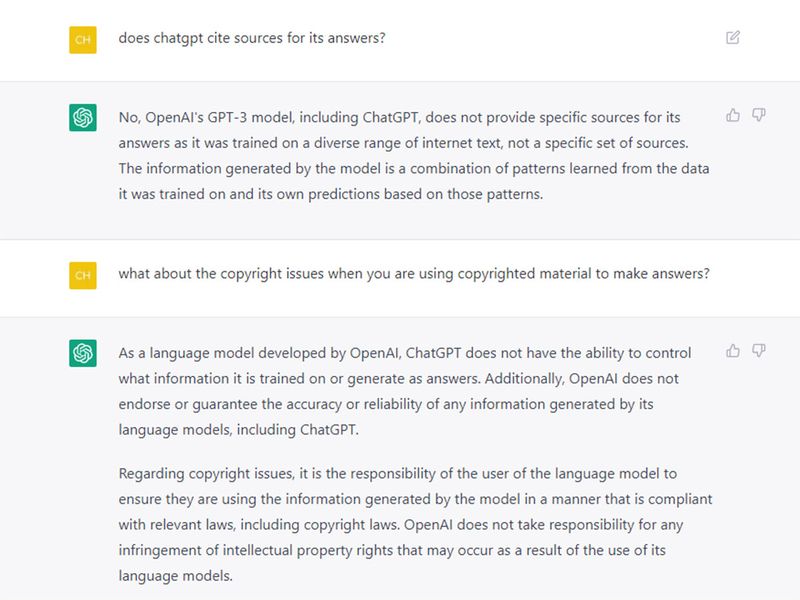
Image Credit:
Can you detect if I have used ChatGPT to create an article?
Well, the whodunnit had started already and is catching up with AI-generated content. The advent of ChatGPT and other tools has raised issues of copyright, plagiarism and original content in concerned circles and OpenAI themselves have come up with a software tool to identify text generated by artificial intelligence. The AI Text Classifier, a language model trained on the dataset of pairs of human-written and AI-written text on the same topic, will be able to distinguish the text written by AI, the makers of ChatGPT claimed in a blog post. A public beta mode has been released but OpenAI cautions the tool is unreliable on texts under 1,000 characters. It also warns the AI-written text can be edited to make it difficult for the classifier to identify.
There are also third-party detection tools like GPTZeroX, which claims to help educators detect AI-generated text.
Can ChatGPT make mistakes?
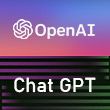
Of course, it can. It is not perfect –yet. However, it is a machine-learning model. It admits mistakes and tries to learn but also does challenge incorrect premises. ChatGPT sometimes writes plausible-sounding but incorrect or nonsensical answers, Open AI had warned in a blog on the date of its release. It also is sensitive to tweaks in the input phrases. For example, it might say it doesn’t know the answer to a particular query, but a slight rephrasing of the question can result in a correct answer.
ChatGPT is also noted to be often wordy and reinstates certain phrases repeatedly. According to OpenAI, these issues are based on ‘biases’ in the training data: such as a preference for longer answers that look more compressive, and over-optimisation.
Biases ingrained in the training data can result in the wrong and prejudiced answers and it can be harmful to minority groups and women, it has been pointed out.
ChatGPT is trying to address the issue by asking users to give feedback on bad answers, but some critics argue that the bot should not have been released to the public before addressing these shortcomings. They cite the instances of Sparrow, a similar chatbot by Google parent Alphabet and Meta’s academic model Galactica.
How does Open AI make money?
Open AI makes money by charging developers to license its technology to generate text and images. Reuters has reported that Open AI aims to generate $1 billion by 2024 through its main products ChatGPT and DALL_E.
Can an individual invest in ChatGPT?
You cant invest in ChatGPT as it is not a company, but a product of OpenAI. You can’t invest in OpenAI either as it is a privately held company and is not a publicly traded one.
When did computers start generating texts?
Computers have been generating text for decades, but deep learning algorithms in the early 2010s marked a breakthrough in the field of natural language generation.
ELIZA, a computer program in the 1960s that simulated a psychotherapist in a text-based interface is one the earliest example. Since then, computers have been used to generate a variety of text-based outputs, including summaries, news articles, and poetry.
With the advent of deep learning, computers have become much better at generating human-like text. Language models such as OpenAI GPT and the like have made it possible to generate text that is nearly indistinguishable from text written by a human.
What are the other products of OpenAI?
OpenAI has several AI products that will change the way we work, do research and approach computing.
These are:
• OpenAI GPT (Generative Pretrained Transformer): A language model that uses deep learning to generate human-like text.
• OpenAI Gym: A toolkit for developing and comparing reinforcement learning algorithms.
• OpenAI DALL-E: A generative model that creates images from textual descriptions.
• OpenAI API: A cloud-based platform for developing and deploying AI models.
• OpenAI Robotics: A research initiative focused on developing advanced AI algorithms for robots and autonomous systems.
• OpenAI Safety: A research initiative focused on ensuring that AI systems are developed and used in ways that are safe for people and the environment.
• AI Text Classifier: A tool to predict the likelihood of a text being generated by AI
What is the difference between Chat GPT and OpenAI GPT?

OpenAI GPT is a general-purpose language model that can be used for a wide range of natural language processing tasks. These include text generation, machine translation, and sentiment analysis. It uses deep learning algorithms to generate text that is similar to human language.
ChatGPT, on the other hand, is a conversational AI model that has been fine-tuned specifically for the task of generating human-like responses in a conversational context. It is designed to be used in applications such as chatbots, virtual assistants, and customer service agents, where the goal is to generate text that is both informative and engaging.
In other words, Chat GPT is the conversational front-end of the language model of the product and it uses OpenAI GPT as its underlying architecture. ChatGPT’s strength is its training in conversational data and this helps it to create human-like responses.
How do machines learn?
Machine learning is based on building algorithms that can detect patterns in data and make predictions or decisions based on that data. Machines learn through ‘training’, in which a model is exposed to a large dataset and its parameters are adjusted to minimize the error between its predictions and the actual outcomes in the data.
Machine learning started in the 1950s and 1960s, when researchers started exploring the idea of machines being able to learn from data. Advances in computer hardware and the availability of large amounts of data in the 90s led to improvements in machine learning algorithms. When big data entered the scene in the 2000s, machine learning became more realistic. Powerful computers enabled them to process large amounts of data quickly, leading to the development of new algorithms such as support vector machines, random forests, and deep learning. These have been instrumental in fields like image and speech recognition, natural language processing, etc.
Are there any companies/apps already using ChatGPT?
Many developers are already using ChatGPT to build conversational AI applications in various fields. We posed this question to ChatGPT and here is the response.
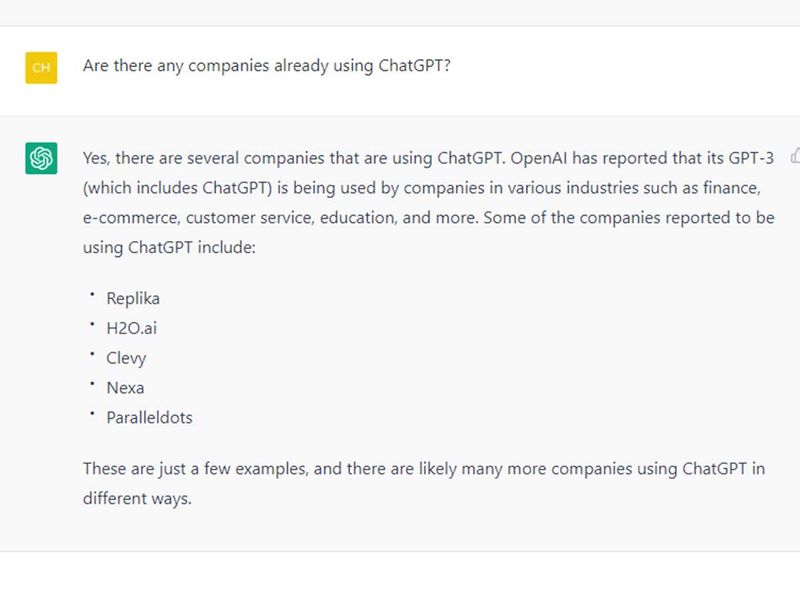
Image Credit:
The massive popularity of OpenAI’s ChatGPT tool has generated a lot of excitement about the potential use cases for AI, Bloomberg reports. As a result, companies who have an interest in AI or simply AI in their names are making huge rallies, it adds.
The frenzy is likely to continue in the near future, and 2023 could very well be the Year of ChatGPT and AI.










